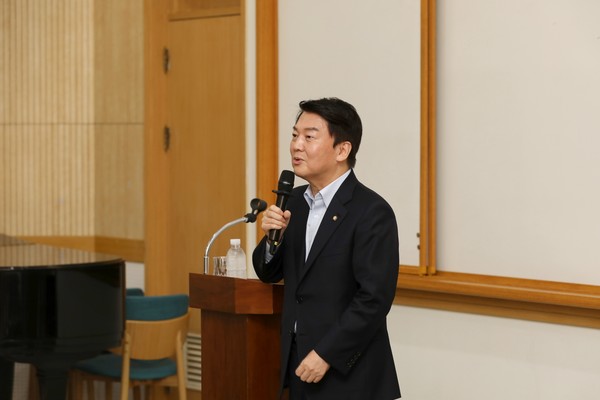
On September 2, Ahn Cheol-soo, a lawmaker of the People Power Party and a first-generation physician-scientist, visited the Graduate School of Medical Science and Engineering (GSMSE) (E7) to deliver a special lecture. The event was jointly organized by the GSMSE and the BioMedical Research Center (BMRC). A total of approximately 50 GSMSE professors, students, and alumni attended the lecture, which focused on the roles and prospects of physician-scientists in future society and how KAIST should prepare for it.
“I thought that sharing my experiences as an ex-physician-scientist could help students in the process of making their career decisions,” said Ahn, who developed V3, the first antivirus software in South Korea, after obtaining an MD. During the lecture, he revealed what motivated him to take this untrodden path. “In my time, there were 30,000 doctors deliberating which career to choose, but I believed I was the only one who could develop an antivirus software. This faith propelled me to pursue a career that could contribute to society, without giving a second thought to the success probabilities.”
Ahn asserted that “among the GSMSE students are potential contributors to the bioindustry, successful startup founders, and competent policymakers who will serve to further develop South Korea.” With regards to the last, he added that “people who know both science and medicine will be an indispensable asset when creating new policies and alleviating regulations.” As an example, he referred to how the US government’s informed decision to simplify regulatory processes accelerated the successful development of mRNA vaccines for COVID-19.
Ahn’s emphasis on the indispensability of integrated studies and knowledge to society coincides with KAIST’s ongoing attempts to nurture transdisciplinary students through the GSMSE. Since its establishment in 2004, the GSMSE has had 245 graduates; among them, 168 became physician-scientists. KAIST aims to increase the GSMSE’s faculty size from 25 to 50 by 2026 and proposes to establish the Medical Science and Technology School to train physician-scientists specifically. Another blueprint for KAIST to expand into the advanced medical industry is to dedicate the Munji campus to biomedicine to foster physician-scientists and physician-engineers. The contribution that KAIST will make to future society through its innovative approaches is greatly anticipated.

